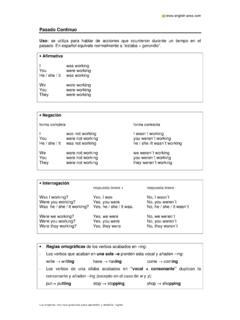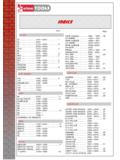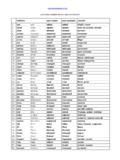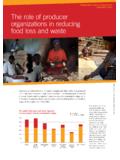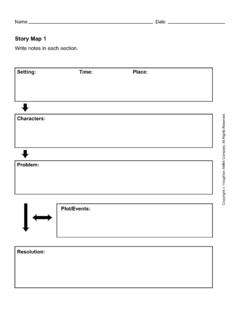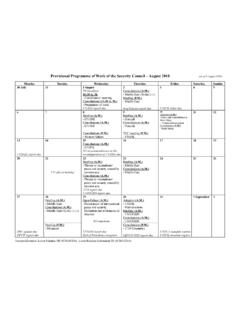Transcription of E-Agriculture Strategy Guide: Piloted in Asia-Pacific ...
1 National E-Agriculture Vision CHAPTER 1. E-Agriculture i Strategy guide .. Piloted in Asia-Pacific countries Published by the Food and agriculture Organization of the United Nations and International Telecommunication Union Bangkok, 2016. National E-Agriculture Vision PART 1. The designations employed and the presentation of material in this information product do not imply the expression of any opinion whatsoever on the part of the Food and agriculture Organization of the United Nations (FAO), or of the International ii Telecommunication Union (ITU) concerning the legal or development status of any country, territory, city or area or of its authorities, or concerning the delimitation of its frontiers or boundaries.
2 The mention of specific companies or products of manufacturers, whether or not these have been patented, does not imply that these have been endorsed or recommended by FAO, or the ITU in preference to others of a similar nature that are not mentioned. The views expressed in this information product are those of the author(s) and do not necessarily reflect the views or policies of FAO, or the ITU. FAO and ITU encourage the use, reproduction and dissemination of material in this information product. Except where otherwise indicated, material may be copied, downloaded and printed for private study, research and teaching purposes, or for use in non-commercial products or services, provided that appropriate acknowledgement of FAO and ITU as the source and copyright holder is given and that FAO's and ITU's endorsement of users' views, products or services is not implied in any way.
3 All requests for translation and adaptation rights, and for resale and other commercial use rights should be made via or addressed to FAO and ITU information products are available on the FAO website ( publications) and ITU website ( ) and can be respectively purchased through and FAO and ITU, 2016. ISBN 978-92-5-109186-9 (FAO). Front cover page photo credit: Back cover page photo credits: Ghosh Nimai Chandra, Saylakham Khayongek, Norman Armedia, Ramesh Soni, Balarka Brahma, FAO/Joan Manuel Baliellas National E-Agriculture Vision CONTENTS. Foreword .. ix Acknowledgements .. x Acronyms and Abbreviations .. xi CONTENTS1. CHAPTER. Explanatory Notes.
4 Xii Introduction .. 4. agriculture and information and communication technology (ICT) .. 4. What is E-Agriculture ? .. 4. The case for E-Agriculture .. 5. Potential benefits of E-Agriculture across value chains .. 7. The need for a national E-Agriculture Strategy .. 11. The need for a national approach .. 12. Determining the appropriate E-Agriculture approach .. 13. iii Structure of this guide .. 16. Part 1: Establishing a National E-Agriculture Vision .. 20. Chapter 1: Framework for a national E-Agriculture vision .. 21. Chapter 2: Manage the vision development process .. 25. Chapter 3: Stakeholder engagement approach .. 31. Chapter 4: Strategic context for E-Agriculture .
5 45. Chapter 5: Learning from E-Agriculture trends and practices .. 59. Chapter 6: Draft an initial vision .. 69. Chapter 7: Identify the required E-Agriculture components .. 79. Chapter 8: Gather information on the current E-Agriculture environment .. 93. Chapter 9: Assess opportunities, gaps, risks and barriers .. 103. Chapter 10: Refine the vision and develop strategic recommendations .. 111. Part 2: Developing a National E-Agriculture Action Plan .. 122. Chapter 1: Need for developing a national E-Agriculture action plan .. 123. Chapter 2: Developing E-Agriculture outputs and activities .. 127. Chapter 3: Develop an integrated action plan.
6 131. Chapter 4: Define implementation phases .. 135. Part 3: Monitoring and 152. Chapter 1: Developing an E-Agriculture monitoring and evaluation framework .. 155. Chapter 2: Define indicators for E-Agriculture .. 159. Chapter 3: Define baseline and target measures for indicators .. 169. Chapter 4: Define supporting governance and processes .. 177. Conclusion .. 190. National E-Agriculture Vision List of Figures Figure : 3G mobile-broadband coverage is extending rapidly into the rural area .. 6. Figure : Mobile broadband subscriptions .. 7. Figure : ICTs in agriculture .. 7. CONTENTS. PART. Figure : The role of ICTs in agriculture .
7 10. 1. Figure : Types of information exchange and examples .. 11. Figure : Methodology for developing a national E-Agriculture Strategy .. 12. Figure : A framework for a national E-Agriculture 21. Figure : Identifying required E-Agriculture components .. 23. Figure : Sample E-Agriculture governance structure .. 27. Figure : Sample timelines for developing a national E-Agriculture vision .. 30. Figure : Four common stakeholder roles involved in developing a national E-Agriculture vision .. 35. iv Figure : Developing the strategic context for the national E-Agriculture vision .. 46. Figure : Agricultural development goals and challenges linked to information flows to achieve specific impacts.
8 58. Figure : Sample visual model for an E-Agriculture vision statement .. 74. Figure : Identifying required E-Agriculture components .. 80. Figure : Gathering information on the current E-Agriculture environment across various components .. 94. Figure : Identifying leverage opportunities, gaps, risks and barriers .. 104. Figure : Steps for refining the E-Agriculture vision .. 113. Figure : E-Agriculture vision and strategic recommendations' development process .. 124. Figure : A template for developing an activity .. 129. Figure : From strategic recommendations to defining the implementation phases .. 130. Figure : Aligning national M&E time frames with implementation phases.
9 170. Figure : Suggested approach to defining target measures for E-Agriculture output indicators .. 172. Figure : Sample governance model for national M&E .. 179. Figure : Example of a national M&E process .. 182. Figure : Logical framework for RBM .. 185. Figure : Relationship of M&E to the results chain .. 187. National E-Agriculture Vision List of Tables Table : Some characteristics of E-Agriculture benefits across value chains .. 8. Table : Examples of governance functions, responsibilities and composition 27. Table : Implications on vision development based on the level of government involvement .. 34. CONTENTS1. CHAPTER. Table : Stakeholder roles in a national E-Agriculture vision.
10 35. Table : Sample stakeholder engagement 38. Table : Types of consultation with stakeholders during each stage .. 39. Table : Sample approach to stakeholder consultations .. 42. Table : agriculture and demographics .. 47. Table : Examples of agricultural extension system dimensions to be explored .. 49. Table : Examples of an agricultural Strategy , goals and priorities .. 53. Table : Strategic goals and challenges: common areas .. 56. v Table : Sample questions for defining E-Agriculture outcomes .. 71. Table : Sample links between E-Agriculture outcomes and agricultural system 73. Table : Sample questions for describing the vision for important stakeholders.










